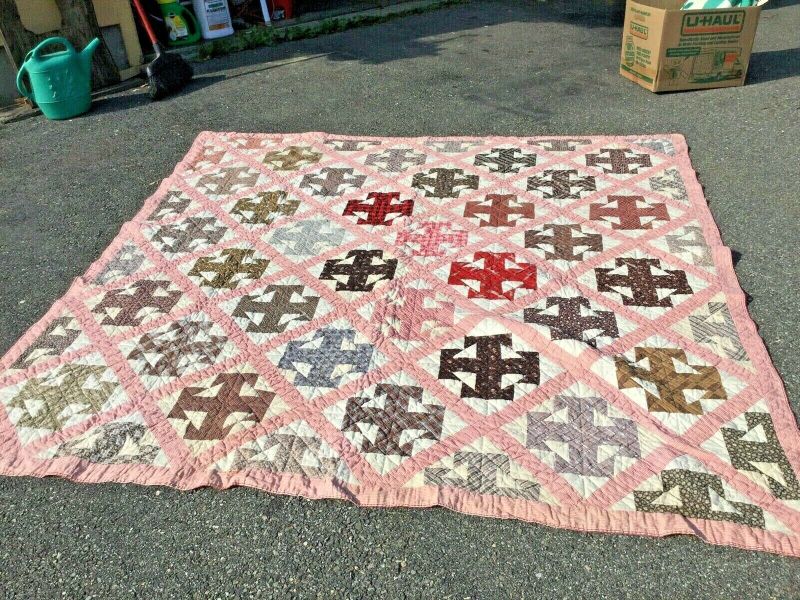T is for Temperance
Note: This post may contain affiliate links. That means we may earn a commission at no additional cost to you if you purchase via our links. Not all links are affiliate links. I only recommend products I use and trust. As an Amazon Associate, I earn from qualifying purchases.
I decided to go into my stash of antique quilts and blocks to show you a temperance quilt block. I haven’t found one yet, but give me time! Meanwhile, here are some others to share with you.

Before I tell you about the Temperance Movement, I have to give you a very generalized view of the life and times of the women who started it. In the early 19th century, women were seen more like servants than companions to their husbands. They had a clearly defined role in their family. They were the caregivers, their husbands were the providers.
So it makes sense that women would not be involved in politics. They didn’t have a reason to leave their home very often and when they did, they wouldn’t have had enough information to form a political opinion, other than their husbands, of course. Women generally didn’t read. They had no need to. Their duties were taught to them by their mothers, and there was no real reason to change.
That all changed with the Civil War. By this time, women WERE learning to read, they were forming their own opinions, men were graciously giving them inheritance rights, and there was even the rare female who worked outside the home. This became a necessity as the war dragged on and the men who were providing for their families didn’t come back. Women were given few choices: find a man to support them, get a job, or commit suicide.
Marry in Haste, Repent at Leisure
The women who married in haste discovered their new husband addicted to drink, and why not? It was socially acceptable and cleaner than the water of the time. But it also led to inconsistent home life, and sometimes to the poorhouse.
After the Civil War, the abolitionist movement was slowing down just as the women’s rights movement was picking up. Suffragists were demanding not only the vote but also equal access to education and employment, a married woman’s right to her own property and wages, custody over her children, and control over her own body.
At that time, children were owned by the father – he could do as he pleased with them. Birth control was a taboo topic. Any discussion on the topic was illegal and could (and did) result in the imprisonment of the women involved.
The temperance movement began prior to the civil war with requests by both men and women that people sign pledges renouncing hard liquor—- promises to drink only beer and wine. Anti-drinking activity reached a peak during the Woman’s Crusade of 1873-74 with women taking direct action to close down saloons. The Women’s Christian Temperance Union was founded in 1874 and immediately began making signature quilts for fundraising, called Crusader Quilts.
However…
There is no indication that these fundraising quilts used the letter T or were drunkards’ path quilts, as commonly supposed. Although the WCTU adopted blue and white as their colors, these fundraising quilts may or may not have been blue and white. The only way to know for sure if a particular quilt is a WCTU fundraising quilt is if the quilt has the letters W.C.T.U embroidered on it.
The Eighteenth Amendment to the US Constitution was passed in 1919 with the belief that banning alcohol would improve virtually all of society’s ills. It was repealed with the 21st Amendment in 1933, leaving the banning of illicit substances in the hands of the individual states.
Here are a few T is for Temperance Quilt Blocks you might want to try.
Click on the caption for a PDF of the design.

 This block was probably used in the quilt above. |  This block is the one used below, just colored differently. |

More Original “T” Blocks
 |  |
Don’t forget to sign up for the newsletter! Once a week, I send updates on quilt-related information I have found while wandering the web. This might be an inspiring article, a tip or tutorial I have discovered (or written), and occasionally exclusive offers & discounts as well as immediate access to the secret page of free patterns, guides, and printables. You can follow my page on Facebook, or join the Make Believe Quilters group, too.










Your story about the temperance movement was very interesting. I had known some of it but your additional information was helpful. Thanks for sharing all the T blocks–also interesting how many variations there are!
This is an interesting spin on the topic for this month. It is very interesting to learn the history behind the blocks and quilts you have shared. Sometimes it is easy to forget the rich history there is in quilting. Thank you for the step back in time.
Very interesting. Thank you
I am sorry that I didn’t leave a comment earlier. I enjoyed all the info and options you included. Thanks for the pattern.
Oh, no worries. I was curious to know if the PDFs for the blocks were useful or not. No one complained, so I guess they must be!
Your temperance a history was interesting. I remember my grandmother was in the WTCU and she occasionally took us to their luncheon. Of course, as 8&9 yr olds we had no idea what they NBC were!I li mmm e seeing the BOMs in color. Thanks